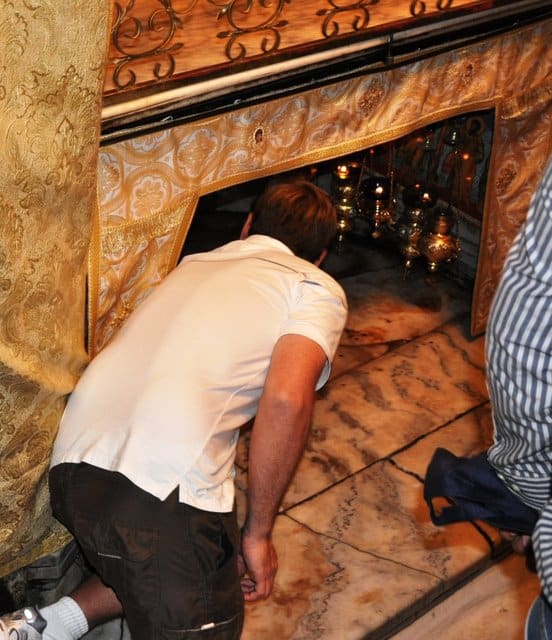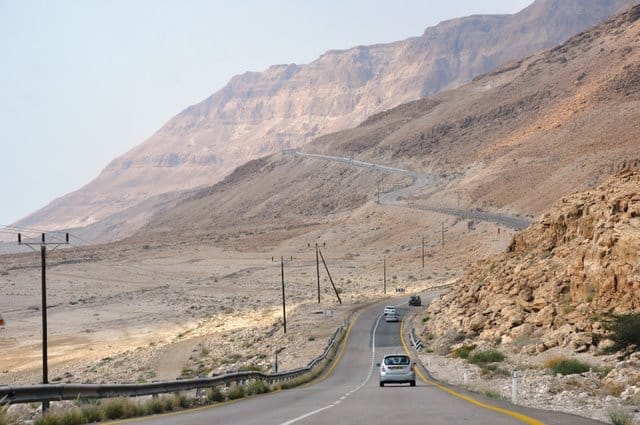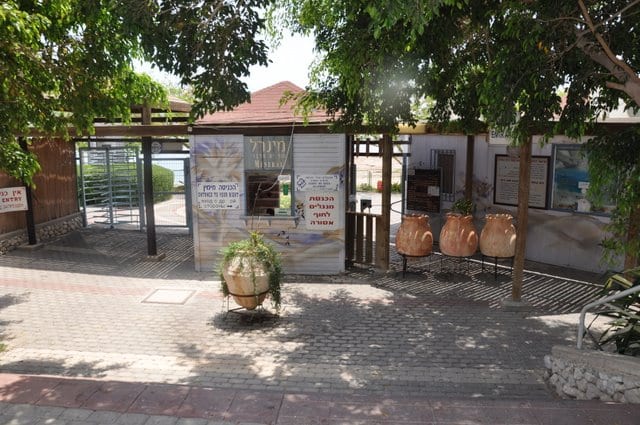Shalom from Israel! I continue to tell you about my amazing trip to the Holy Land. This week we head to the Dead Sea, Masada and Bethlehem which is in Palestine.

DRIVE TO MASADA
In case you missed it, last week we left off from Jerusalem. Using our hotel as a home base, we made a couple day trips to popular (and unpopular) attractions. Our first trip was to Masada. Our guide, Amir, picked Natalie and I up at 8:30am for the 75-minute drive. To get to Masada we had to drive past the lowest place on earth, the Dead Sea.
CAMEL PHOTO OP
The highway for the descent was brand new and wide. Along the way we passed sea level markers and many Bedouin camps – here the Bedouins live in shacks, not tents. To take a quick break and a photo op for Natalie on a camel, we stopped at a sea level sign. The photo op was 15 Shekels, but we gave him 10 and he took it. The road then turned into this picturesque drive that reminded me of the California coast. We drove along the Dead Sea. As we passed a huge section of palm trees, we saw the AHAVA Israeli Cosmetic factory that uses Dead Sea minerals (their products are popular in the States). We were so close to Jordan (on the other side of the Dead Sea) that my cell phone got a welcome text message stating: “Enjoy GPRS Services to assist you during your stay in Jordan.”
MASADA
Masada is a huge tourist draw and has been declared a UNESCO World Heritage Site. The word ‘masada’ means ‘fortress’ in Hebrew. Masada is the site of a complex of palaces built by King Herod the Great around 37 BC. He designed it as a refuge in the event of an attack against him since he was a friend of the Romans. Although the remains are basically a pile of rubble, you can see it was more than a safe haven. Today it’s a symbol of Jewish heroism since this was the site of the Jewish rebels’ last stand against the Romans. Instead of being defeated, at the very end they committed mass suicide (supposedly two women survived, by hiding in a well, to tell the story).
GETTING UP AND DOWN MASADA
To get to the top of the 1,300-foot (400-meters) high palace, we took the 3-minute cable car that leaves every 15 minutes. It costs 67 INS for a return ticket, 49 INS for a one-way or 25 INS if you want to walk up and down. I walked down by myself, which took 25 minutes. The path was steep at parts and my fear of heights kicked in so bad at one point that my knees were shaking. It was the middle of the day, so I was all by my lonesome for the descent. But, I did pass 7 hikers walking up (3 of them Americans) who gave me motivation. TIP: Bring sunscreen, a hat and water and go early in the morning.
MINERAL BEACH
From Masada it was a 15-minute drive back along the road we took to a place called Mineral Beach. It’s not the fanciest beach at the Dead Sea, but it has everything one desires: chairs, mud, showers, lockers, spa treatments, souvenirs and a café. The entrance fee, I believe, is 55 INS (the sign is in Hebrew and I can’t remember what we paid).

THE DEAD SEA
The “beach” here is rough gravel and is hot so you’d best bring water shoes. It’s surreal to think that you are about to swim in the Dead Sea, with Jordan just a few miles across, and you are at the lowest place on earth – 417 meters below sea level. The Dead Sea is called “dead” because it is so salty that no life can survive here. Its maximum length is 42 miles (67 km) and the max width is just 11 miles (18 km). FLOATING IN THE DEAD SEA When I rolled up I saw a guy floating and it looked so unreal I literally thought he had “floaties” between his legs but he didn’t. I slowly waded into the salt water, fearing having any unknown open cuts (I would be screaming) but all I felt was a little sting on my arm where I had a scratch. Once I was up past my waist, I started to float on my back. I probably had the same sensation astronauts do in space. It was remarkable! I felt like a kid as I put my hands up in the air proving I wasn’t touching the ground. You really can’t sink. Other bathers in deeper water appeared to be standing…but they weren’t, which was even freakier. TIP: For a cool photo op bring a magazine or newspaper to read.
PLAY IN THE MUD
Afterwards, I went over to the mud spring, which was like quick sand. I jumped in as fast as I could since my feet were burning (like a fool I didn’t have water shoes). My whole leg was submerged in mud and I could barely pull it out, but since nothing lives in the Dead Sea I wasn’t worried about any predators. I coated my body with the dark mud and let it sit for the 20 to 30 minutes recommended for the minerals to soak in and do the body some good. I went back into the water to rinse off and then to the fresh water showers to wash any places I missed, including my face. My skin was so smooth afterwards. WARNING: Don’t put your head in the water, don’t drink it and don’t get it in your eyes. According to Amir, swallowing just a little will make you sick and ingesting a half cup will kill you. Gulp!
KOSHER LUNCH
I had a sandwich at the Mineral Bath Café. Their set up is like Subway so I chose my bread, meat and fresh veggies (turkey Pastrami on wheat, with tomatoes, peppers and onions). I asked for some cheese, which was also in the display next to the meats, but the worker said that’s not possible because it’s Kosher. I guess cheese and meat can’t go together, so I had to order a separate plate of cheese and put it on myself; total cost was 20 INS and it was way better than Subway. FYI: It took an hour to get back to the hotel.
BETHLEHEM
The following day, Amir (our incredible guide) dropped us about ten minutes from Jerusalem, at the West Bank Border (Palestinian Authority Territory). Israeli law doesn’t allow Israelis to pass this point, so he arranged for us to be picked up by a Palestinian driver from the Bethlehem Souvenir Center Co. The shop provided us with transportation and a guide for free. The only catch was that we had to go into their store at the end of the tour. There was no pressure to buy anything (at all), but everyone does (including us) because the experience at the church is so amazing you want keepsakes to remember it. FYI: You can pay with your credit card, U.S. Dollars, Euros or the territory’s currency, which is Jordan Dinar or the New Israeli Shekel.
CROSSING THE BORDER
Palestine isn’t a country yet, so there’s no real border crossing or stamps to add to your passport. Actually, no one looked at our passports or stopped us. An Israeli guard peaked into our vehicle on the way in and out and that was it.
CHURCH OF THE NATIVITY
Our driver was very friendly and he took us five minutes from where he picked us up, at Bet Jalla, to Bethlehem. We met up with our guide a block from the Church of the Nativity. You’ve probably heard of it since it’s one of the most famous in the world. They broadcast Christmas Eve mass from here to all over the world and it’s also one of the oldest continuously operating churches. The structure was built over the cave that tradition marks as the birthplace of Jesus. It is a combination of two churches: one is the Greek Orthodox Patriarchate of Jerusalem and the other is the Church of St. Catherine. There’s also another denomination presiding there, the Armenian Apostolic.
HISTORY OF THE CHURCH
The first basilica built here was completed in 333 AD. It burned down in the Samaritan Revolt of 529 AD and was rebuilt in its present form in 565 AD by the Emperor Justinian I. To enter through the main door requires going through the Door of Humility built by the Turks. The door was built so low (it only goes up to about my chest) to prevent locals from rushing in on their horses. It thereby forces them to dismount and, perhaps unintentionally, pay their respects as they bow to enter.

WHERE JESUS WAS BORN
The highlight, of course, is touring around the grotto beneath the basilica, which enshrines the site where people believe Jesus was born. A 14-point silver star, set in the marble floor under an Armenian Apostolic altar, marks the exact spot. The other altar in the crypt, about 15 feet away, marks where Mary laid the newborn baby in the manger and that’s maintained by the Roman Catholics. There was an Eastern European tour group down there and they were singing “O Come, All Ye Faithful” in their native tongue which added even more reverence to the atmosphere. WOW It’s difficult to convey what I felt when I went down the stairs to see the exact spot where Jesus was born. Words can’t describe it, but for sure I will never forget it. It’s still difficult for me to fathom that I saw the actual place that I’ve been told about countless times. It never really seemed real. From now on, hearing the stories and attending midnight mass at Christmas will have a newer and more profound meaning for me.
WEST BANK
I was nervous about going to the West Bank; the only thing I knew about it was from the violent images on T.V. Someone told me it’s like Tijuana, so I almost didn’t even go. But that’s not the case at all. I felt safe. One kid tried to sell me gum, and one teenager hassled me to buy postcards, but that’s it. Everyone I saw seemed happy. It was just every-day life taking place; kids going to school, women shopping and men selling beans on the side of the road. I also saw a bunch of nice houses – nothing like what’s portrayed on the major networks. There’s really not much to do in the West Bank, so basically it’s a two-hour trip. Besides seeing the church and getting olive wood souvenirs, the other place of real interest is the wall that Israel put up that the Palestinians are upset about. I have no opinion, but many Israelis I spoke to say it really has helped with the suicide bombings. So if that’s what it takes, so be it.
Web Resources



































